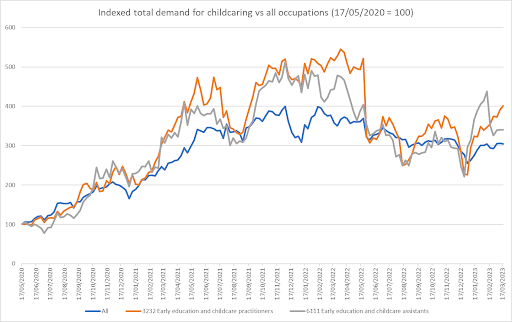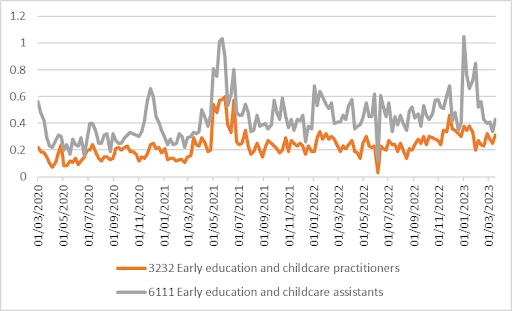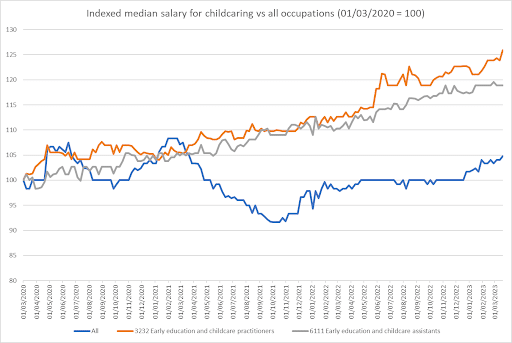The Budget and the childcare sector
12 Jun 2023
Daniel Muir, Research Economist (Fellow)
This blog was written just after the Spring Budget and was originally published on the website of Adzuna, one of the largest online job search engines in the UK.
Some of the biggest policy measures announced in the recent Spring Budget related to childcare support. Allowing those on Universal Credit to access support upfront as opposed to in arrears, which will reduce any funding gaps and ease the transition into the payment cycle for childcare costs, was broadly well received.
The maximum amount of support that UC claimants are eligible to receive also increased significantly by about 50%, welcome news for these individuals given that these are individuals that are feeling the bite of the Cost-of-Living crisis the most.
One measure that has stirred up more debate though was the main one – the major expansion of the 30 hours of free childcare to all pre-school children. Previously this was for just parents of children aged three to four, now it will cover parents of all children from age nine months.
The scheme will be rolled out in phases, with 15 hours a week offered to all two-year-old children from April 2024, 15 hours a week offered to all children from nine months old from September 2024 and an additional 15 hours for working parents of all children from nine months from September 2025.
The Office for Budget Responsibility forecast that by 2027/28, 60,000 additional people will enter employment and will work an average of around 16 hours a week as a result of the support. They also project an equivalent effect on total hours coming from the 1.5 million mothers of very young children already in work increasing the hours they work – assuming those 60,000 additional employed work 48 weeks a year, this works out at about 31 additional hours a year worked by each of these mothers already in the labour force. They also forecast a further increase in employment of around 15,000 by 2027/28 from the aforementioned change to how childcare support is paid to those claiming UC.
The extension of the 30 hours will come at a cost of around £5bn a year by 2026 for a full breakdown of the policy costs over time. As an aside, one should be wary of a simple cost-per-job type-appraisal of policies, for example, the widely touted ‘£70,000 per job’ figure in relation to the entire work plan package in the budget.
That’s not to say that these measures are or are not effective employment measures, but rather that the economic evaluation of public policy should be a far more complex and nuanced task than a simplistically calculated cost per outcome figures – cost per outcome figures have their uses, but valuing an outcome with as many internal and external benefits to the individual in question and society as whole as employment is a complex process – see the Treasury’s Green Book for guidance on the principles of cost-benefit analysis.
A focus of the Budget on employment and raising participation (by helping more people who are outside of the labour force get back in and helping people at risk of leaving work to stay) though is welcome. Our economy is facing serious labour and skills shortages. We are seeing higher levels of economic inactivity amongst those with long-term health conditions and a weak employment recovery amongst older people since the pandemic, plus a recent rise in the proportion of young people that are NEET.
Alongside this, there are more than a million unfilled vacancies. This is holding back growth and may be adding to pay pressures in the private sector (where nominal pay growth is above 6% a year) as well as recruitment and retention problems in public services (where pay growth is barely 2%).
But whilst these childcare measures should boost employment and help reduce labour and skills shortages across the wider economy, they will likely worsen labour and skills shortages in one particular area – the childcare sector.
According to the Childcare and Early Years Provision survey, there were 339,800 childcare providers in 2022 in England, up 3.4% from 2021 (328,500). 252,100 of these staff worked in group-based provision, 53,400 staff worked in school-based provision and 34,300 were childminders and assistants. According to the Labour Force Survey, the largest childcaring SOC occupations were 6111 Early education and childcare assistants (139,700 employed) and 3232 Early education and childcare practitioners (77,500 employed).
The sector is already facing serious issues with recruiting and retaining qualified staff (practitioners need to have achieved an early years degree qualification, such as Early Years Professional, Early Years Teacher, Early Childhood Studies Degree, or Early Childhood Graduate Practitioner Competencies, and assistants require a certificate from the Council for Awards in Children’s Care and Education as well as potentially an NVQ/SVQ in Child Care and Education or equivalent qualification up to level 3).
The government will increase the maximum allowable staff: child ratios from 1:4 staff to children to 1:5 to combat this, which has been met with sharp criticism from sector experts including the Early Years Alliance – this is despite a public consultation on the issue finding that most providers would be unlikely to make the change because of safety concerns and staff workload.
Looking at Adzuna data on vacancies, it provides further insights on the skills and labour shortages faced in the sector. Over the past year (April 2022 – April 2023) there have been 19,600 vacancies for childcare practitioners, 37,300 vacancies for childcare assistants, 14,500 vacancies for 6114 Childminders and 3,300 vacancies for 6117 Playworkers. Growth in demand for the main childcaring roles has matched/ exceeded growth in demand for all other occupations since the pandemic trough of mid-May 2020, although the fall in demand in the sector through the pandemic was steeper than for all areas of the economy as many parents reclaimed childcaring responsibilities through the lockdowns.

The supply for these occupations can be proxied by Adzuna’s Interest Quotient. This is a measure of relative interest in occupations by jobseekers – an IQ above 1 means that jobseekers are relatively more interested in listings for a given occupation than in listings across all occupations. Looking at the chart below, we see that the IQ for both childcare practitioners and assistants has remained largely below 1, and by quite some margin especially for practitioners, meaning that there is relatively little interest in these roles from job seekers.

The (rightly necessary) qualification entry requirements on these occupations will be one factor that might put jobseekers off. Another will be low salaries – across the past year, the median listed salary for vacancies for both Early education and childcare assistants was £21,500, 33% less than the median salary of £30,000 across all vacancies over the same period. As such, there has been substantial growth in average listed salaries – 20-25% since pre-pandemic, compared to 5% growth for all jobs – in order to incentivise entry and to reduce the mismatch between demand and supply.

The government plans to encourage more childminders into the sector by rolling out a pilot scheme offering a £600 incentive for new joiners and a £1,200 incentive for those who joined through a childminding agency. Given the size of the gap in earnings between roles in the sector and those readily available and unfilled in the wider economy, this incentive equal to at most 5.6% of median listed salaries is likely to have a minimal impact in sourcing the necessary labour and skills required to fill current vacancies plus the roles created as the number of childcare places required increases as a result of the policy measures announced. The phased roll-out of the measure will give providers time to source the additional labour and skills they require – we will see though whether they are able to find, attract, and retain it.
Any views expressed are those of the author and not necessarily those of the Institute as a whole.

